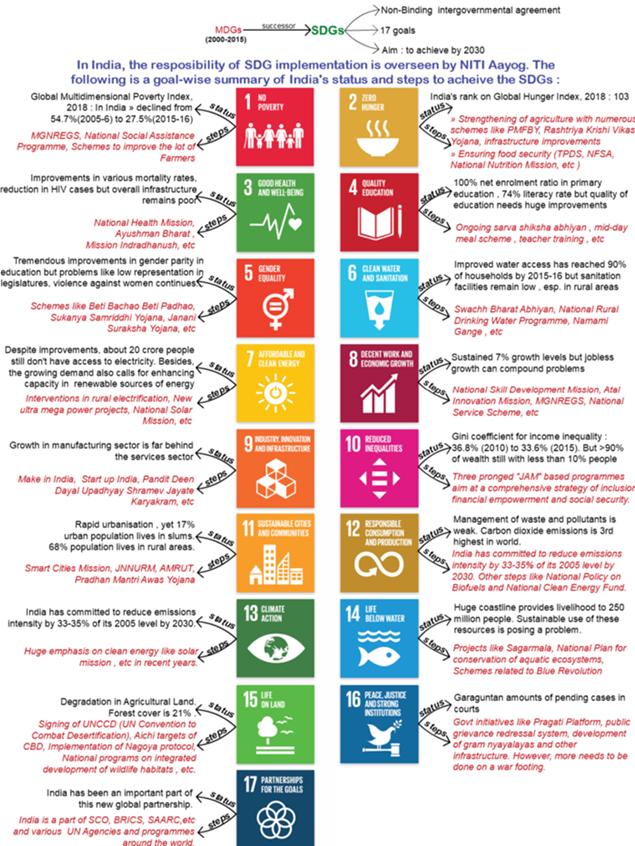Overview of India’s 2023-24 SDG Index Performance
India improved its SDG Index score to 71 out of 100, up from 66, demonstrating advancements in key areas like poverty reduction, economic growth, and clean energy.
Key Achievements
- Energy Access: Nearly universal electricity access, with 96% of households now having access to clean cooking fuel.
- Sanitation: All districts have achieved Open Defecation Free (ODF) status, indicating significant progress in sanitation and hygiene.
- Climate Action: Increased renewable energy capacity and better compliance with environmental standards have bolstered India’s climate efforts.
- Economic Growth: Enhanced tax participation and reduced extreme poverty reflect economic progress.
State Performance
- Top Performers: Kerala and Uttarakhand scored highest, with 79 points each.
- States with Most Gains: Punjab, Manipur, and West Bengal made notable improvements, reflecting targeted SDG initiatives.
- Low Performers: Bihar (57) and Jharkhand (62) scored lower, highlighting regional disparities in SDG progress.
Areas Needing Improvement
- Gender Equality: Minimal gains were seen in gender equality, indicating a need for increased focus and resources.
- Income Inequality: Limited progress in reducing income inequality, with further steps needed to address consumption gaps and socioeconomic divides.
- Food Security: Despite improvements, malnutrition and food security require more targeted interventions to meet the 2030 goals.

Moving Forward
To sustain momentum and address challenges, India must enhance its efforts in gender equality, food security, and reducing inequality through comprehensive policies and community engagement
Contingency Mapping and Adaptive Pathways – Agenda 2030
Ideal Interactions vs. Real-World Trade-offs
- Synergies in Theory: Ideally, the Sustainable Development Goals (SDGs) work in harmony, creating co-benefits that drive sustainable progress.
- Challenges in Practice: In reality, interactions between SDGs can lead to trade-offs and tensions, which can hinder progress. For instance, while SDG 2 (Zero Hunger) aims to increase food production, intensive agricultural practices often negatively impact biodiversity on land (SDG 15) and in water ecosystems (SDG 14).
The Role of Contingency Mapping
- Strategic Tool: Contingency Mapping serves as a valuable approach for steering sustainable development toward the 2030 Agenda. By evaluating contrasting future scenarios, this method highlights both trade-offs and potential win-wins within complex social-ecological systems.
- Creating Future Visions: Contingency Mapping enables the crafting of stories and visions for the future, allowing people to better assess and choose the types of futures they aspire to achieve.
Adaptive Pathways for Inclusivity
- Diverse Perspectives: while Shaping flexible, actionable strategies based on imagined future contexts using contingency mapping, a range of beliefs, values, and aspirations from different stakeholders can be incorporated, reflecting the plurality of views essential for a sustainable future.
- Pinpointing Necessary Changes: This inclusive approach helps identify specific SDG interactions that may need adjustments to achieve desired, sustainable futures via creation of flexible pathways to pivot effectively as future outcomes unfold.

